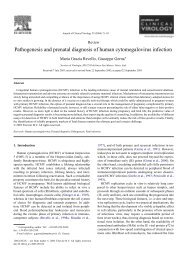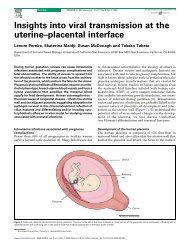Congenital Cytomegalovirus Conference - Congenital CMV ...
Congenital Cytomegalovirus Conference - Congenital CMV ...
Congenital Cytomegalovirus Conference - Congenital CMV ...
You also want an ePaper? Increase the reach of your titles
YUMPU automatically turns print PDFs into web optimized ePapers that Google loves.
P-34 <strong>CMV</strong> Association in Extrahepatic Biliary Atresia: Awareness Needed for Prevention and Early Treatment.<br />
Vineeta Khare, Prashant Gupta, Janak Kishore. Department of Microbiology, Sanjay Gandhi Post Graduate<br />
Institute of Medical Sciences, Lucknow, India.<br />
Background: In India, serological surveys have shown the prevalence of <strong>CMV</strong> antibodies in adult population to be<br />
about 80-90%. <strong>Cytomegalovirus</strong> (<strong>CMV</strong>) infection has been implicated in the causation of extrahepatic biliary atresia<br />
(EHBA) in neonates born to <strong>CMV</strong> infected females. Incidence of EHBA in newborns of <strong>CMV</strong> infected females is not<br />
known in India. Treatment is surgical and prognosis is good only when it is done before the infant attain the age of 8<br />
weeks thus requiring early referral.<br />
Objectives: To determine the frequency with which patients with EHBA are infected with <strong>CMV</strong> and to ascertain the<br />
age at referral to a specialty centre for surgical correction of EHBA.<br />
Methods: 74 cases of biopsy proven EHBA were managed at Sanjay Gandhi Post Graduate Institute of Medical<br />
Sciences, Lucknow from January 2005 through May 2008. IgM antibody detection in serum for <strong>CMV</strong> was done<br />
using ELISA kit. The data analyzed included age, sex, clinical presentation, age at referral, Liver function tests, urine<br />
examination, abdominal ultrasonography, hepatobiliary scintigraphy, liver biopsy, management, complications and<br />
follow-up.<br />
Results: Out of 74 EHBA cases, 53 were male and 21 female. 22 (29.7%) were positive for IgM antibodies for <strong>CMV</strong>.<br />
Age of onset of jaundice ranged from since birth to 60 days. The mean age at referral was 14 weeks (range 4-32<br />
weeks). Kasai Portoenterostomy (PE) was performed in 19 infants and the mean age at surgery was 15 weeks (range 4<br />
to 36 weeks). 54 children could not undergo Kasai PE because either they were more than 20 weeks old or presented<br />
with extensive liver cirrhosis or due to financial constraints of parents. 1 patient died.<br />
Conclusions: <strong>CMV</strong> infection was present in 29.7% of patients with EHBA at the time of referral. Although jaundice,<br />
pale stools and dark urine were observed in early infancy, referral was always late. Seeing <strong>CMV</strong> association in EHBA,<br />
awareness programs among Indian pregnant females for prevention of <strong>CMV</strong> infection are necessary and possibility<br />
of EHBA must be kept in mind when evaluating jaundiced infants born to <strong>CMV</strong> positive females.<br />
P-35 Evidence of sub-therapeutic concentrations in a pediatric population receiving ganciclovir.<br />
Suzanne Luck, A. Lovering, P. Griffiths, M. Sharland. Royal Free and University College Medical School, London, UK.<br />
Background: Ganciclovir (GCV) may be commenced in infants with congenitally or postnatally acquired<br />
cytomegalovirus (<strong>CMV</strong>) infection and in immunocompromised patients who become viraemic. The dose of IV GCV<br />
recommended in the children’s British National Formulary is 5mg/kg twice daily, although higher doses have been<br />
studied for treatment of congenital <strong>CMV</strong>. Doses of oral valganciclovir used vary even more widely. Reference ranges<br />
are often quoted for adults but some of the evidence on which these are based is contentious and how these relate to<br />
treatment and viral suppression in infants is unknown.<br />
Objectives: To evaluate GCV levels from specimens received for routine diagnostic purposes by a national reference<br />
laboratory in the United Kingdom (UK).<br />
Methods: Serum GCV levels (reported in mg/L) received by the UK Antimicrobial Reference laboratory in Bristol<br />
from 01/11/1999 to 31/3/2007 were reviewed. GCV levels from samples received from different pediatric age groups<br />
were analyzed and compared to those obtained from adults (individuals more than 18 years of age).<br />
Results: 95 specimens were received from 32 patients aged < 6 months (28% of all specimens received and 25% of all<br />
patients). The median trough level seen in infants aged





